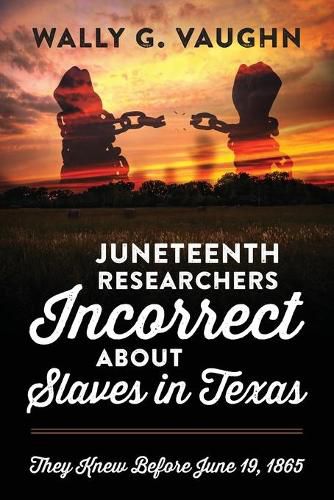Readings Newsletter
Become a Readings Member to make your shopping experience even easier.
Sign in or sign up for free!
You’re not far away from qualifying for FREE standard shipping within Australia
You’ve qualified for FREE standard shipping within Australia
The cart is loading…






This title is printed to order. This book may have been self-published. If so, we cannot guarantee the quality of the content. In the main most books will have gone through the editing process however some may not. We therefore suggest that you be aware of this before ordering this book. If in doubt check either the author or publisher’s details as we are unable to accept any returns unless they are faulty. Please contact us if you have any questions.
Juneteenth proponents claim that slaves in Texas first heard of the Emancipation Proclamation on June 19, 1865, two and a half years after it became effective. United States Navy vessels monitored the coast of Texas and slaves of owners in Texas ran away under the Emancipation Proclamation and enlisted in the Union Navy as early as January 1863. Confederate military records detailed that some of them were captured January 21, 1863, after a fight between Union and Confederate vessels off Sabine Pass, Texas. Nearly a dozen sailors that had absconded from owners were crew members on the U. S. S. Morning Light when captured by enemy forces that day. The Union Army landed in Texas during the second half of 1863 and recruiting slaves to enlist and fight their owners to help end the contest was an objective. Major General Napoleon J. T. Dana wrote to his superior from Brownsville, Texas, on December 2, 1863: Thirty-three men have been mustered in for the Twenty-sixth Regiment, Corps d'Afrique… Beginning in 1863 slaves ran away from owners at Galveston and accessed Union vessels that were part of the fleet in Galveston Bay. Slaves continued to respond to the Emancipation Proclamation in 1864 accessing Union vessels on the coast of Texas and enlisting in the Union Army. An abundance of critical information escaped Juneteenth researchers that soundly confirmed slaves in Texas were aware of the Emancipation Proclamation two and a half years earlier than asserted. In this publication readers will be shown the missteps made by Juneteenth researchers and how these gaffes brought them to the erroneous conclusion that slaves in Texas first became aware of the Emancipation Proclamation on June 19, 1865.
$9.00 standard shipping within Australia
FREE standard shipping within Australia for orders over $100.00
Express & International shipping calculated at checkout
This title is printed to order. This book may have been self-published. If so, we cannot guarantee the quality of the content. In the main most books will have gone through the editing process however some may not. We therefore suggest that you be aware of this before ordering this book. If in doubt check either the author or publisher’s details as we are unable to accept any returns unless they are faulty. Please contact us if you have any questions.
Juneteenth proponents claim that slaves in Texas first heard of the Emancipation Proclamation on June 19, 1865, two and a half years after it became effective. United States Navy vessels monitored the coast of Texas and slaves of owners in Texas ran away under the Emancipation Proclamation and enlisted in the Union Navy as early as January 1863. Confederate military records detailed that some of them were captured January 21, 1863, after a fight between Union and Confederate vessels off Sabine Pass, Texas. Nearly a dozen sailors that had absconded from owners were crew members on the U. S. S. Morning Light when captured by enemy forces that day. The Union Army landed in Texas during the second half of 1863 and recruiting slaves to enlist and fight their owners to help end the contest was an objective. Major General Napoleon J. T. Dana wrote to his superior from Brownsville, Texas, on December 2, 1863: Thirty-three men have been mustered in for the Twenty-sixth Regiment, Corps d'Afrique… Beginning in 1863 slaves ran away from owners at Galveston and accessed Union vessels that were part of the fleet in Galveston Bay. Slaves continued to respond to the Emancipation Proclamation in 1864 accessing Union vessels on the coast of Texas and enlisting in the Union Army. An abundance of critical information escaped Juneteenth researchers that soundly confirmed slaves in Texas were aware of the Emancipation Proclamation two and a half years earlier than asserted. In this publication readers will be shown the missteps made by Juneteenth researchers and how these gaffes brought them to the erroneous conclusion that slaves in Texas first became aware of the Emancipation Proclamation on June 19, 1865.